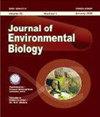米佐拉姆三种潜在豆科绿肥作物的分解和养分释放模式
IF 0.7
Q4 ENVIRONMENTAL SCIENCES
引用次数: 0
摘要
目的:本实验采用垃圾袋技术了解 Crotolaria micans Link、Aeschynomene indica L. 和 Calopogonium mucunoides Desv. 的分解和养分释放动态(氮、磷和钾)。方法:在植物生长旺盛期采收这些物种,风干一周。将风干样本(10 克)装入 20 厘米 X 20 厘米的尼龙网袋中,埋在为每个物种准备的 1.5 米 X 1.5 米实验地中 10 厘米深的土壤中。每月取回网袋,测定质量和养分损失。结果C. micans 的腐烂率最高(每年 7.67 千克),其次是 C. mucunoides(每年 7.15 千克)和 A. indica(每年 5.50 千克)。在分解期间,钾的释放速度最快。腐烂率与初始木质素、总酚和木质素/N呈负相关,其中总酚(R2 = 0.956)和木质素/N比(R2 = 0.832)对腐烂的影响最大。解释:研究表明,该物种可有效地用作土壤养分输入源,其中 C. micans 似乎是最有潜力的物种,可作为绿肥作物进一步研究和开发。关键词分解 腐烂率 绿肥 豆科植物 养分释放本文章由计算机程序翻译,如有差异,请以英文原文为准。
Decomposition and nutrient release pattern of three potential leguminous green manure crops of Mizoram
Aim: The experiment was carried out to understand the decomposition and nutrient release dynamics (N, P and K) of Crotolaria micans Link, Aeschynomene indica L. and Calopogonium mucunoides Desv. using the litter bag technique. Methodology: The species were harvested at their peak vegetative stage and air-dried for a week. Air-dried samples (10 g) were placed in 20 cm X 20 cm nylon mesh bags and buried at 10 cm soil depth in an experimental plot of 1.5 m X 1.5 m prepared for each species. The bags were retrieved monthly, and the mass and nutrient loss were determined. Results: C. micans had the highest decay rate (7.67 k per year), followed by C. mucunoides (7.15 k per year) and A. indica (5.50 k per year). During the decomposition period, K release was the fastest. The decay rate was negatively correlated with initial lignin, total phenol and lignin/N of which the total phenol (R2 = 0.956) and lignin/N ratio (R2 = 0.832) had the most significant influence on decomposition. Interpretation: The study reveals that the species can be effectively utilized as a soil nutrient input source of which C. micans seems to be the most potential species to be further researched and developed as a green manuring crop. Key words: Decomposition, Decay rate, Green manure, Legume, Nutrient release
求助全文
通过发布文献求助,成功后即可免费获取论文全文。
去求助
来源期刊

Journal of environmental biology
ENVIRONMENTAL SCIENCES-
CiteScore
1.70
自引率
0.00%
发文量
92
审稿时长
3 months
期刊介绍:
Information not localized
 求助内容:
求助内容: 应助结果提醒方式:
应助结果提醒方式:


